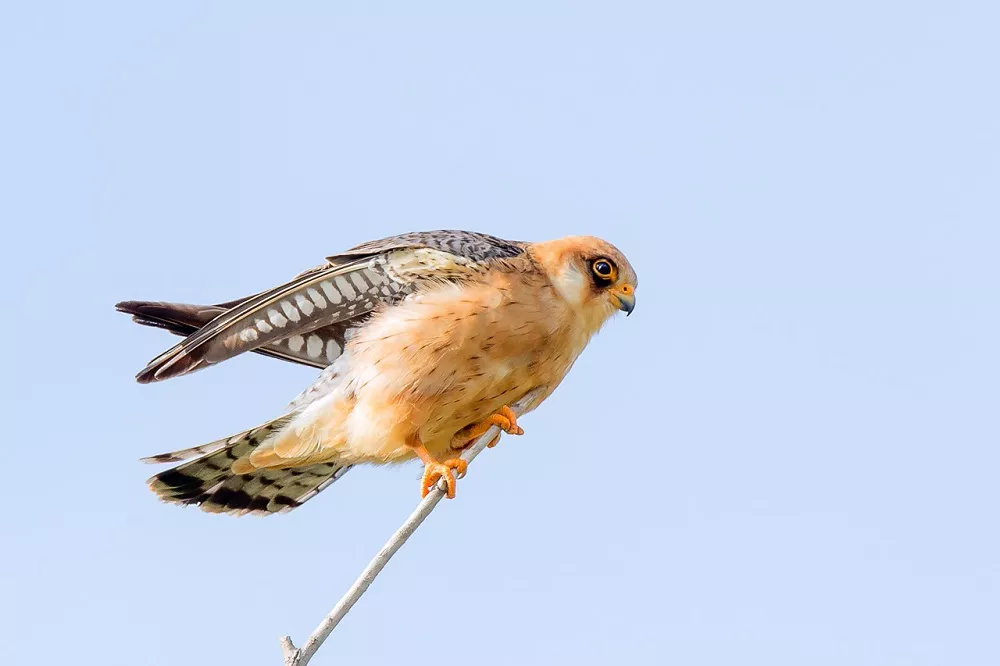The Red-footed Falcon (Falco vespertinus) is a captivating bird of prey that belongs to the Falconidae family. Known for its striking appearance and unique behaviors, this species has captured the attention of ornithologists and bird enthusiasts alike. In this article, we will delve into the key features, distribution, habitat, behavior, and conservation status of the Red-footed Falcon.
Appearance:
The Red-footed Falcon is a medium-sized bird with a length of approximately 28 to 33 centimeters and a wingspan ranging from 70 to 84 centimeters. Males and females exhibit significant sexual dimorphism. Adult males are recognized by their stunning breeding plumage, which includes a slate-blue head and back, reddish underparts, and distinctive red feet. In contrast, adult females and immature individuals have a more subdued appearance, featuring a brownish coloration with streaks and a white underside.
Distribution and Habitat:
The Red-footed Falcon is a migratory species that has a vast breeding range extending from Eastern Europe and Central Asia to Mongolia. During the non-breeding season, these birds undertake long-distance migrations to sub-Saharan Africa, primarily occupying savannahs, grasslands, and open woodlands. They are known to frequent a variety of habitats, including agricultural areas and wetlands, where they can find an abundance of insects and small vertebrates.
Behavior and Diet:
Red-footed Falcons are highly agile birds renowned for their exceptional aerial hunting skills. They have a preference for catching insects, such as dragonflies, beetles, and grasshoppers, mid-flight. With their streamlined bodies and rapid flight speed, they are adept at maneuvering through the air and seizing prey with their sharp talons. Although primarily insectivorous, Red-footed Falcons occasionally feed on small birds, bats, and reptiles.
Breeding and Reproduction:
Breeding season for Red-footed Falcons typically begins in late spring or early summer. They are known to nest in colonies, often in association with other raptors, such as Common Kestrels. The females construct nests in tree hollows, crevices, or old nests of other birds, utilizing materials such as twigs, grass, and feathers. The female typically lays a clutch of 3 to 6 eggs, which are then incubated by both parents for around 27 to 30 days. Once hatched, the chicks are cared for and fed by both parents until they fledge after approximately 30 to 35 days.
Conservation Status:
The Red-footed Falcon faces several conservation challenges, primarily due to habitat loss and degradation. The conversion of natural habitats into agricultural lands and the excessive use of pesticides have resulted in a decline in insect populations, which constitute a vital part of the falcon’s diet. Furthermore, deforestation and the removal of old trees have reduced the availability of suitable nesting sites. As a result, the International Union for Conservation of Nature (IUCN) lists the Red-footed Falcon as a globally vulnerable species. Conservation efforts aimed at protecting and restoring their habitats, promoting sustainable agricultural practices, and raising awareness about the importance of these birds are crucial for their long-term survival.
Conclusion:
The Red-footed Falcon is a captivating bird species that stands out with its vibrant plumage, agile flight, and remarkable hunting abilities. As a migratory bird, it traverses vast distances and occupies various habitats throughout its annual cycle. However, the species faces significant threats, underscoring the importance of conservation measures to safeguard their future. Understanding and appreciating the unique characteristics and ecological significance of the Red-footed Falcon can contribute to our efforts in protecting this magnificent bird of prey for generations to come.


 Facebook
Facebook  Instagram
Instagram  Youtube
Youtube 